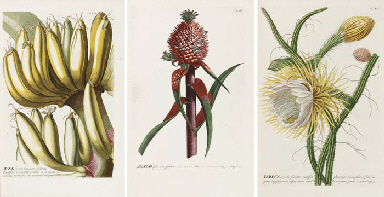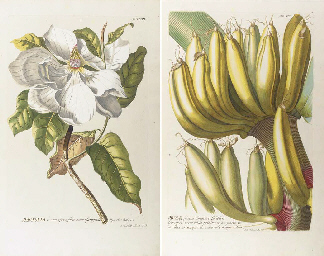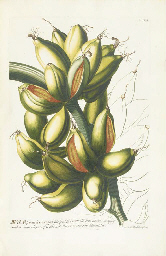TREW, Christoph Jakob (1695-1769) and Benedict Christian VOGEL (1745-1825). Uitgezochte Planten . Translated from Latin into Dutch by Cornelius Pereboom. Amsterdam: Christian Sepp [1769]-1771-[1774]. 2° (527 x 360mm). 2pp. subscriber's list. 3 mezzotint portraits of Trew, G.D. Ehret and J.J. Haid, 100 fine hand-coloured engraved plates after Ehret, the final ten with Haid's name as engraver, every plate with the first word of the caption heightened in gold. (Light staining to upper margin of plate LI, plate LXII with rubbing to the image with some loss of pigment.) Contemporary Dutch tree calf, covers panelled in gilt with central decorative shaped rococo panel composed from various small tools including stylised foliage and a shield supported by two putti, the spine in nine compartments with raised bands, red morocco lettering-piece in the second, the others variously tooled in gilt (neatly rebacked with original spine laid down, corners renewed). AN EXCELLENT COPY OF SEPP'S VERY RARE DUTCH EDITION OF PLANTAE SELECTAE . Long recognised as an outstanding botanical work, it was the vehicle for Ehret to achieve 'realism, majesty, ineffable color, all in one breathtaking look' (Hunt). Linnaeus himself informed Trew (in Latin) that 'The miracles of our century in the natural sciences are your work of Ehret's plants, Edward's work of birds and Roesel's of insects, nothing to equal them was seen in the past or will be in the future'. Born in Heidelberg in 1710, Georg Dionysius Ehret originally worked as a gardener, practicing drawing in his spare time. His artistic abilities led him into the service of a Regensburg banker named Leskenkohl who commissioned him to copy plates in van Rheede tot Draakestein's Hortus indicus malabaricus (1678-1703). It was during this period that he met Trew, a physician and amateur botanist, who became a loyal friend and patron. Ehret moved to London in the late 1730s, where he painted the recently introduced exotics at the Chelsea Physic Garden and established himself as a teacher of flower-painting and botany. By 1742 publication of the Plantae selectae was already planned. Trew wrote to Christian Thran in Carlsruhe to say: 'Every year I receive some beautifully painted exotic plants [by Ehret] and have already more than one hundred of them, which with other pieces executed by local artists, should later on ... constitute an appendicem to Weinmann's publication' (Gerta Calman, Georg Ehret, Flower Painter Extraordinary , 1977, p. 97.) Discussions about the projected work continued by letter until 1748 when Johann Jacob Haid from Augsburg agreed to produce the engravings from Ehret's drawings. The work finally appeared in ten parts between 1750 and 1773. The publication of the present translation began in 1769 (the year Trew died), and Pereboom included a short epilogue (on p. 72) dated Hoorn, 25 October 1774. The images, which are finely hand-coloured, are identical with those in the Nuremberg edition, but the first 90 plates do show some variation in the engraved text, and the engravers' names are omitted. Only 63 copies for this Dutch edition were subscribed for, and it is significantly rarer on the market than the Latin edition. Landwehr 199; Nissen BBI 1998; cf. Stafleu & Cowan 15,131.
TREW, Christoph Jakob (1695-1769) and Benedict Christian VOGEL (1745-1825). Uitgezochte Planten . Translated from Latin into Dutch by Cornelius Pereboom. Amsterdam: Christian Sepp [1769]-1771-[1774]. 2° (527 x 360mm). 2pp. subscriber's list. 3 mezzotint portraits of Trew, G.D. Ehret and J.J. Haid, 100 fine hand-coloured engraved plates after Ehret, the final ten with Haid's name as engraver, every plate with the first word of the caption heightened in gold. (Light staining to upper margin of plate LI, plate LXII with rubbing to the image with some loss of pigment.) Contemporary Dutch tree calf, covers panelled in gilt with central decorative shaped rococo panel composed from various small tools including stylised foliage and a shield supported by two putti, the spine in nine compartments with raised bands, red morocco lettering-piece in the second, the others variously tooled in gilt (neatly rebacked with original spine laid down, corners renewed). AN EXCELLENT COPY OF SEPP'S VERY RARE DUTCH EDITION OF PLANTAE SELECTAE . Long recognised as an outstanding botanical work, it was the vehicle for Ehret to achieve 'realism, majesty, ineffable color, all in one breathtaking look' (Hunt). Linnaeus himself informed Trew (in Latin) that 'The miracles of our century in the natural sciences are your work of Ehret's plants, Edward's work of birds and Roesel's of insects, nothing to equal them was seen in the past or will be in the future'. Born in Heidelberg in 1710, Georg Dionysius Ehret originally worked as a gardener, practicing drawing in his spare time. His artistic abilities led him into the service of a Regensburg banker named Leskenkohl who commissioned him to copy plates in van Rheede tot Draakestein's Hortus indicus malabaricus (1678-1703). It was during this period that he met Trew, a physician and amateur botanist, who became a loyal friend and patron. Ehret moved to London in the late 1730s, where he painted the recently introduced exotics at the Chelsea Physic Garden and established himself as a teacher of flower-painting and botany. By 1742 publication of the Plantae selectae was already planned. Trew wrote to Christian Thran in Carlsruhe to say: 'Every year I receive some beautifully painted exotic plants [by Ehret] and have already more than one hundred of them, which with other pieces executed by local artists, should later on ... constitute an appendicem to Weinmann's publication' (Gerta Calman, Georg Ehret, Flower Painter Extraordinary , 1977, p. 97.) Discussions about the projected work continued by letter until 1748 when Johann Jacob Haid from Augsburg agreed to produce the engravings from Ehret's drawings. The work finally appeared in ten parts between 1750 and 1773. The publication of the present translation began in 1769 (the year Trew died), and Pereboom included a short epilogue (on p. 72) dated Hoorn, 25 October 1774. The images, which are finely hand-coloured, are identical with those in the Nuremberg edition, but the first 90 plates do show some variation in the engraved text, and the engravers' names are omitted. Only 63 copies for this Dutch edition were subscribed for, and it is significantly rarer on the market than the Latin edition. Landwehr 199; Nissen BBI 1998; cf. Stafleu & Cowan 15,131.






.jpg)

.jpg)





Testen Sie LotSearch und seine Premium-Features 7 Tage - ohne Kosten!
Lassen Sie sich automatisch über neue Objekte in kommenden Auktionen benachrichtigen.
Suchauftrag anlegen